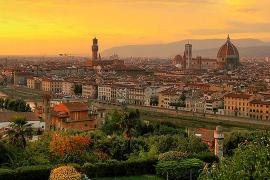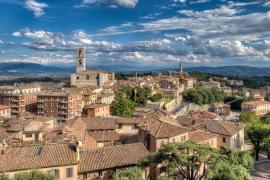
TUSCANY
Unique region in the world.
Birthplace of the Italian Renaissance, genius, art, famous for its cultural heritage and natural beauty unmatched.Two, and distinctly different, are the main tourist flows: one addressed to art, lively since the last century, which is concentrated around the museums and monuments of Florence, Siena, Pisa and many other cities, large and small (like San Gimignano and Cortona); and one addressed to the seaside resorts, especially regarding Viareggio and Versilia, but also the islands of the Tuscan archipelago, as the island of Elba, and Grosseto, as Porto Santo Stefano, at the base of Monte Argentario.
The agritourism has had a great development lately. Farmhouses are the highlight of accommodation in Tuscany. Often derived from ancient farmhouses, they are characterized by an elegant yet rustic charm. In step with the times, the majority of farmhouses in Tuscany are equipped with the latest amenities. The region also has the famous spas, starting from Montecatini Terme, in the province of Pistoia; expanding mountain tourism in the highest areas of the Apennines, especially in the ski resort of Abetone. Protagonist of national art and culture in several moments of their long evolution, Tuscany still has alive signs of its history; it is not a simple legacy of the past but an original patrimony persistent and able to renew itself. The region, in fact, is still very vital from the point of view of culture and is able to exploit its artistic patrimony, without damaging it, but reworking it in a creative way. This is confirmed by the fact that UNESCO has included in the world cultural heritage five sites of this region. Tuscan wine and food culture can be defined as ancient and wise, characterized by fresh ingredients, which are prepared with different recipes.
Among the typical Tuscan remember ribollita (bread soup, cabbage and beans), pappardelle with hare sauce or duck of the Aretino, the gnocchi of the Casentino (with spinach and ricotta), pici of Siena, panzanella, and even those made with fish from the Tyrrhenian coast (the famous fish soup and the mullet of Livorno). Among the second courses dominate the hunting meat (such as wild boar, prepared in cacciatore way, stewed etc.) and normal meat: especially known are the Florentine (beef steaks with the bone) on the grill. Often accompanied by the characteristic bread without salt and thick crust and extra virgin olive oil, it is the cold cuts (ham and sausages, but also finocchiona,biroldo, soprassata). Outstanding are also the wines, which are devoted more than ten thematic routes: from the very famous DOCG Brunello di Montalcino, Chianti, Carmignano, Vino Nobile di Montepulciano, Vernaccia di San Gimignano to the many DOC wines, such as Ansonica, white Pitigliano , Colli Etruria Centrale Elba, the Montecarlo, the Morellino di Scansano, the Rosso di Montalcino, Rosso di Montepulciano, San Gimignano, the Sant'Antimo, the virgin white wine of the Val di Chiana. Deserve a particular mention the vin santo wine, liqueur made from dried grapes, andalchermes, lively red, still used in confectionery.
Among the many products we can mention the DOP Tuscan pecorino cheese, Tuscan ham and chestnut flour of Garfagnana. The IGP has been attributed, among others, to the Tuscan olive oil, chestnuts from the Mugello, Garfagnana spelled and Colonnatalard.

